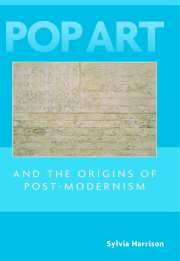Conclusion
Published online by Cambridge University Press: 23 July 2009
Summary
It has been argued in this study that during the sixties in America a post-modernist critical consciousness arose in response to those aspects of American, or, more accurately, New York pop that could not be adequately accommodated within existing formalist and realist critical canons. In the face of their abject failure to come to terms with the character of an art as complex as pop, together with the character of the society that gave it birth, critics turned to a range of radical sociological and philosophical theories. These same theories, as in the prominent cases of pragmatism and phenomenology, we may now retrospectively identify with deconstructive notions of post-modernism and post-modernity.
Critical interest in pop art (or, for that matter, the production of art indebted to pop ideas) did not suddenly cease with the time frame of this study: the sixties and shortly thereafter. To the contrary, pop art's unabated relevance is attested by the substantial body of literature on the subject that stretches in an unbroken fashion from the movement's inception to the present time. Post-modernism's emergence as a worldview in the midseventies, however, undoubtedly endowed pop with a further lease of life: by affirming the movement's significance, it stimulated a new wave of critical attention. As Lynne Cooke has rightly pointed out, the principal issues of “simulation and appropriation” and “commodification of the artwork” in Warhol's pop especially (particularly the last) coincided with those at the heart of the post-modernist controversy of the eighties.
- Type
- Chapter
- Information
- Pop Art and the Origins of Post-Modernism , pp. 208 - 222Publisher: Cambridge University PressPrint publication year: 2001



